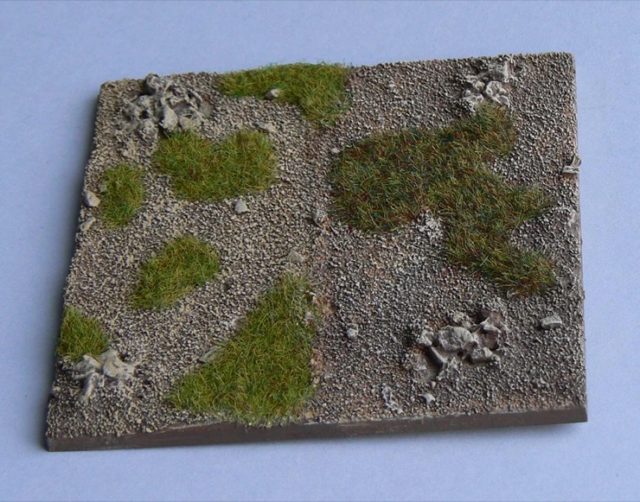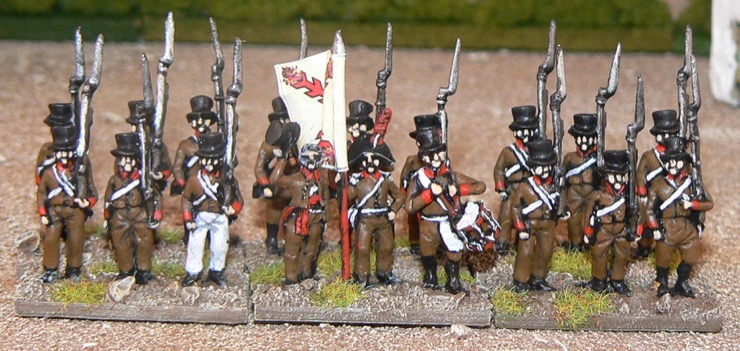A method inspired by Mark Case’s blog on Basing the Hussars. Mark specialises in the Peninsular War, which rang a bell, so I thought I’d give it a go for my own Peninsular Spanish.
An infantry battalion for my Spanish Army of the Peninsular War. Both the battalion and the base board are flocked the same way.

Materials
This is what you need:
- Super glue
- White wood glue / PVA
- Modelling sand:
- Games Workshop Modelling Sand (this is what I started with but it is terribly expensive)
- Pet supply sand
- Lumpy bits / Tiny rocks
- Kitty litter (the trouble with kitty litter is that it absorbs moisture; which is what it is for, right)
- Woodland Scenics Plastic Coarse Talus 21.7 Cubic Inches-Brown
- Earth coloured paint, for example:
- Tamiya Flat Earth (XF-52)
- Dulux Colour Sampler Tinted Code 80YR14140 250 ml Extra Deep W27. At 2.60 for 250 ml this works out much cheaper than buying the Tamiya paint.
- Dark Sand coloured paint, for example any of:
- Vallejo 70847 Dark Sand (this is what I use because I couldn’t find Ceramcoat in the UK)
- Ceramcoat Maple Sugar Tan (this is Mark Case’s preferred shade)
- Cote D’arms 522 Pale Sand (despite the “Pale” in the title it is quite similar to the Vallejo)
- Americana DA191 Camel
- Pale Sand coloured paint, for example any of:
- Vallejo 70837 Pale Sand
- Howard Hues Geo-Hex Desert (I originally used this because Mark Case suggested it and I only found the alternatives later)
- Static Grass (see Want a replacement for Games Workshop Static Grass? Try Noch or Javis)
- Noch Static Grass Summer Meadow
- Javis Static Grass No 2 Summer Mix
- Games Workshop Static Grass (strangely I find this a dryer look than the GW Burnt Static Grass which is dark green and red)
For all the paints check out Dulux Paints for Wargaming Bases and Terrain.
Method
The method goes like this:
- Glue the figures to the base:
- I normally use PVA but use super glue for tricky customers than won’t stand up
- Leave to dry
- Glue on sand
- Paint exposed surface of the base with diluted white glue.
- Dunk the base in the GW modelling sand.
- Randomly apply spots of diluted white glue to the base.
- Drop lumpy bits in the glue as boulders or groups of smaller bits (e.g. Kitty Litter) to form piles of rocks
- Leave to dry.
- Paint sand an earth colour
- Paint the whole stand with a slightly diluted coat of earth colour.
- Leave to dry.
- Dry brush with sand colours
- Heavy dry brush a dark sand colour
- Leave to dry, not that it will take long. Basically seconds is enough.
- Light dry brush a pale sand colour
- Leave to dry, not that it will take long.
- Glue on flock
- Randomly apply spots of diluted white glue to the base.
- Dunk the base in the static grass.
- Optionally glue on labels such Unit IDs for Crossfire.
Here are some grass samples



Variations when Rebasing
I quite like the effect so I have redone my Russian Naval Infantry and Spanish Civil War. Others will follow.
Spanish Civil War Variation
My Spanish civil war figures were originally based using a rough sand, large cat litter, and a fine flock. I didn’t bother starting again with the the Games Workshop sand mix and just painted directly over the original flock.
Spanish Civil War: Republican HMG Company. Note: Unit ID for Crossfire = “P” for Popular Army.
Naval Infantry Variation
I had already plastered my Russian Naval Infantry Battalion when I decided to use this approach to flocking. I didn’t bother gluing on sand and just painted the plaster. This is quite similar to how Roland Davis bases.
Russian Naval Infantry Battalion: Assault Platoon. Note: Unit ID for Crossfire = “N” for Naval.



